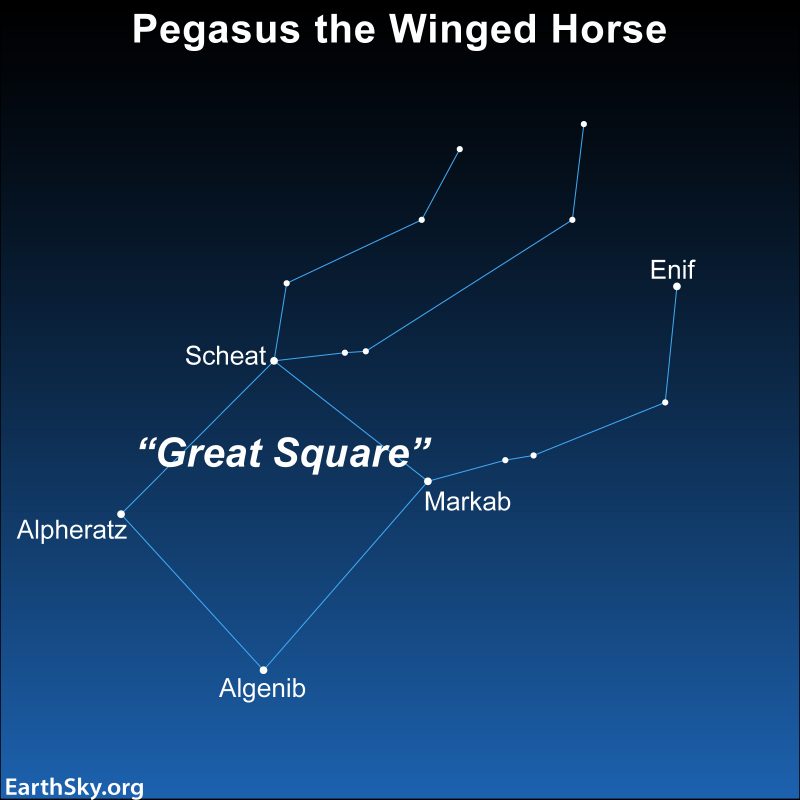
Pegasus the Winged Horse
Pegasus the Winged Horse is the seventh-largest of the 88 constellations. It rises in the east on autumn evenings in the Northern Hemisphere (spring evenings in the Southern Hemisphere). And it dominates the sky with its giant, square-shaped asterism, called the Great Square. In mythology, Pegasus was the winged horse that Perseus the Hero rode when he saved Princess Andromeda from Cetus the Whale. These four constellations all group together in the sky now, illustrating stories told in ancient Greece some 3,000 years ago.
Pegasus is easy to find. On fall evenings in the Northern Hemisphere, it climbs above the eastern horizon, reaching a spot nearly overhead by late fall. Its asterism – the Great Square of Pegasus – is huge. The square alone is 20 degrees wide from top to bottom. That’s the span of two fist-widths held at arm’s length.
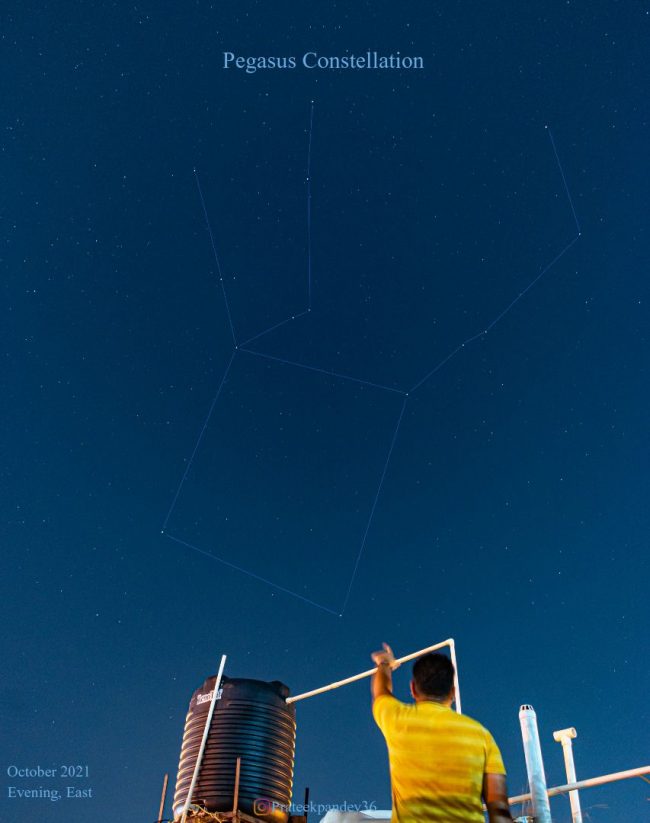
Stars of Pegasus
The star in the Great Square closest to the horizon is Algenib, with a magnitude of 2.8. It lies 333 light-years away. The star on the opposite corner of the square from Algenib is Scheat, a magnitude 2.4 star lying 199 light-years away. The star to the south in the square is Markab, a magnitude 2.5 star at a distance of 140 light-years. And the final star in the square is Alpheratz. Technically, Alpheratz lies just across the border of Pegasus and is actually a member of the constellation Andromeda. Alpheratz is the brightest of the four stars at magnitude 2.1 and lies 97 light-years away.
The Great Square marks the body of the winged horse. Trails leading off the west side of the square mark the front legs and head of Pegasus. Extending out from Markab, two stars at magnitude 3.4 and 3.5, Homam and Biham, lead the way to the head star, magnitude 2.4 Enif. This star will be helpful in finding the globular cluster M15.
Find the forelegs of Pegasus off of Scheat. Five degrees west of Scheat is magnitude 3.0 Matar. As the brightest leg star in Pegasus, it’s helpful in finding a couple of notable galaxies.
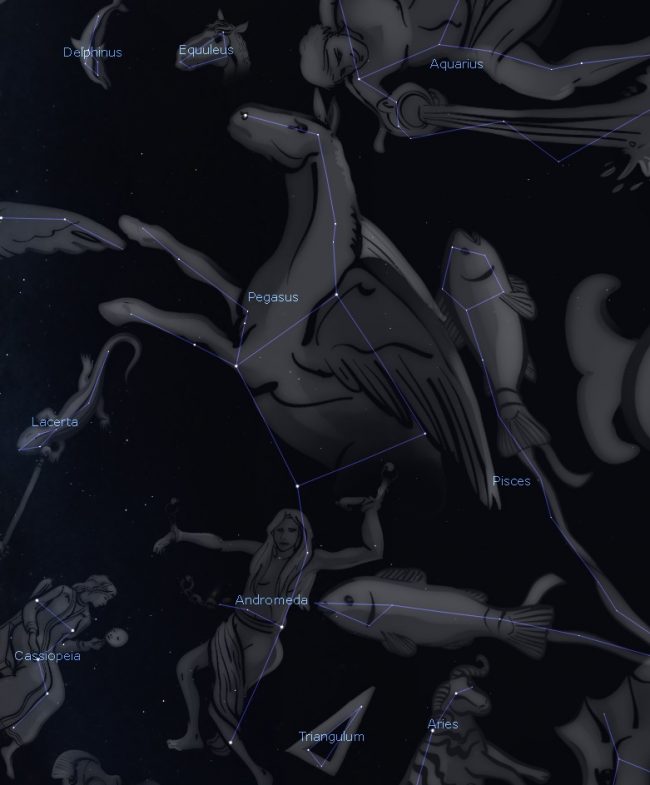
Galaxies in Pegasus the Winged Horse
Four notable galaxy clusters lie in Pegasus. The brightest is magnitude 9.5 and has the curious name Deer Lick Group. Follow Scheat to Matar and then about 4.5 degrees farther and slightly north of the direction you were heading. This will bring you to the Deer Lick Group, NGC 7331. Here you’ll find one large spiral galaxy and a spattering of smaller ones.

Only 1/2 degree south of the Deer Lick Group is the famous Stephan’s Quintet, a popular target among astrophotographers. This tight gathering of five galaxies has a magnitude of 13.6. The largest and brightest, NGC 7320, has a small redshift compared to the other four, revealing that it is probably not a physical member of the group and just a line-of-sight coincidence.
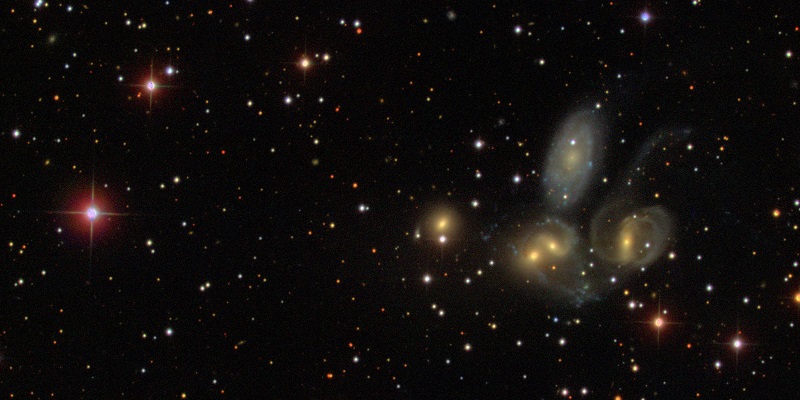
The Pegasus I Cluster lies on the southern edge of the constellation not far from the circlet of Pisces. At a distance of 8 degrees from Markab on the sky’s dome, the Pegasus I Cluster is a magnitude 11.1 grouping. The galaxy cluster requires a large telescope to see or a long-exposure photograph, but it reveals a beautiful and striking number of galaxies.
The Pegasus II Cluster lies back within the square of Pegasus. Halfway between Alpheratz and Scheat, it lies just inside the border of a line that would be drawn connecting these two stars. A bit dimmer at magnitude 12.6, the Pegasus II Cluster (NGC 7720) is a powerful radio source, the target of much scientific study.
Globular Cluster M15 in Pegasus the Winged Horse
One other deep-sky object of note in Pegasus is the globular cluster M15. You can find M15 easily using the head and neck stars of Pegasus. Start with the star Markab and follow it along the two dimmer stars that mark the neck. From the last star of the neck (Biham) to the brighter head star Enif, continue a line straight out for a little more than 4 degrees. Here you will find the magnitude 6.4 globular cluster M15. It lies about 33,600 light-years away and will show up nicely in a pair of binoculars.

The asterism of the Great Square
The Great Square of Pegasus can also look like a huge diamond. Think of it as a giant baseball diamond rising during playoffs month in the east after dark. Asterisms, such as the Great Square, are groups of stars that haven’t been labeled as constellations but are easy to recognize.

Using Pegasus to find the Andromeda Galaxy
Pegasus is close to the constellation Andromeda, so it’s useful for star-hopping to the Andromeda Galaxy. You’ll need a dark-sky site to track down Andromeda without optical aid. It’s much easier to spot with binoculars or a telescope. Follow this link for more information on how to use Pegasus to find Andromeda.
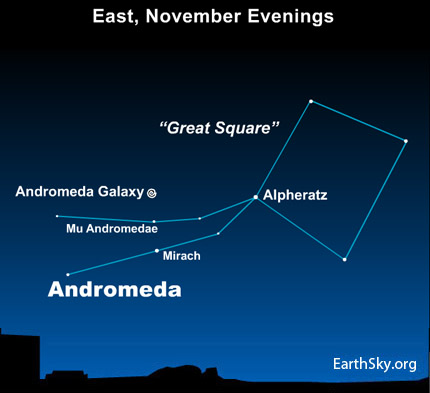
First exoplanet around a sun-like star
Astronomers discovered the first exoplanet orbiting a sun-like star in the constellation Pegasus. They named the planet 51 Pegasi b, after the star it was orbiting. Didier Queloz and Michel Mayor discovered the planet in 1995 and received the Nobel Prize in Physics for their discovery in 2019.
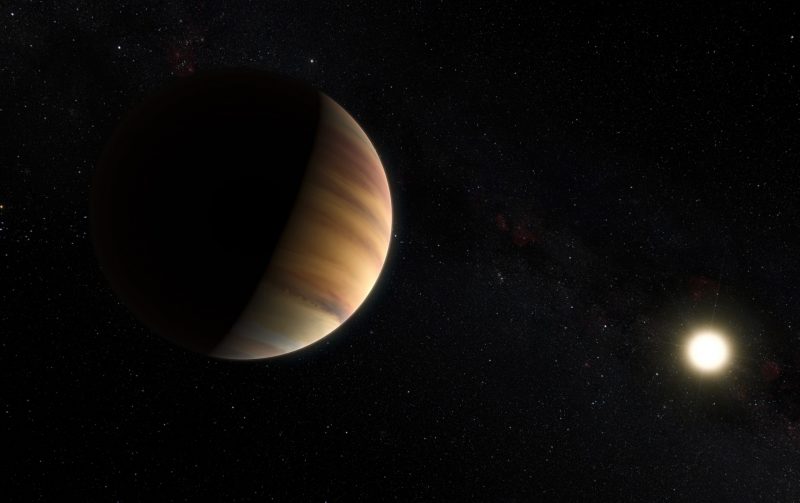
Bottom line: Pegasus the Winged Horse is a giant constellation that dominates autumn skies in the Northern Hemisphere (spring skies in the Southern Hemisphere). The constellation contains a famous asterism called the Great Square.
The post Pegasus the Winged Horse dominates autumn skies first appeared on EarthSky.
from EarthSky https://ift.tt/3bvRFzi

Pegasus the Winged Horse
Pegasus the Winged Horse is the seventh-largest of the 88 constellations. It rises in the east on autumn evenings in the Northern Hemisphere (spring evenings in the Southern Hemisphere). And it dominates the sky with its giant, square-shaped asterism, called the Great Square. In mythology, Pegasus was the winged horse that Perseus the Hero rode when he saved Princess Andromeda from Cetus the Whale. These four constellations all group together in the sky now, illustrating stories told in ancient Greece some 3,000 years ago.
Pegasus is easy to find. On fall evenings in the Northern Hemisphere, it climbs above the eastern horizon, reaching a spot nearly overhead by late fall. Its asterism – the Great Square of Pegasus – is huge. The square alone is 20 degrees wide from top to bottom. That’s the span of two fist-widths held at arm’s length.

Stars of Pegasus
The star in the Great Square closest to the horizon is Algenib, with a magnitude of 2.8. It lies 333 light-years away. The star on the opposite corner of the square from Algenib is Scheat, a magnitude 2.4 star lying 199 light-years away. The star to the south in the square is Markab, a magnitude 2.5 star at a distance of 140 light-years. And the final star in the square is Alpheratz. Technically, Alpheratz lies just across the border of Pegasus and is actually a member of the constellation Andromeda. Alpheratz is the brightest of the four stars at magnitude 2.1 and lies 97 light-years away.
The Great Square marks the body of the winged horse. Trails leading off the west side of the square mark the front legs and head of Pegasus. Extending out from Markab, two stars at magnitude 3.4 and 3.5, Homam and Biham, lead the way to the head star, magnitude 2.4 Enif. This star will be helpful in finding the globular cluster M15.
Find the forelegs of Pegasus off of Scheat. Five degrees west of Scheat is magnitude 3.0 Matar. As the brightest leg star in Pegasus, it’s helpful in finding a couple of notable galaxies.

Galaxies in Pegasus the Winged Horse
Four notable galaxy clusters lie in Pegasus. The brightest is magnitude 9.5 and has the curious name Deer Lick Group. Follow Scheat to Matar and then about 4.5 degrees farther and slightly north of the direction you were heading. This will bring you to the Deer Lick Group, NGC 7331. Here you’ll find one large spiral galaxy and a spattering of smaller ones.

Only 1/2 degree south of the Deer Lick Group is the famous Stephan’s Quintet, a popular target among astrophotographers. This tight gathering of five galaxies has a magnitude of 13.6. The largest and brightest, NGC 7320, has a small redshift compared to the other four, revealing that it is probably not a physical member of the group and just a line-of-sight coincidence.

The Pegasus I Cluster lies on the southern edge of the constellation not far from the circlet of Pisces. At a distance of 8 degrees from Markab on the sky’s dome, the Pegasus I Cluster is a magnitude 11.1 grouping. The galaxy cluster requires a large telescope to see or a long-exposure photograph, but it reveals a beautiful and striking number of galaxies.
The Pegasus II Cluster lies back within the square of Pegasus. Halfway between Alpheratz and Scheat, it lies just inside the border of a line that would be drawn connecting these two stars. A bit dimmer at magnitude 12.6, the Pegasus II Cluster (NGC 7720) is a powerful radio source, the target of much scientific study.
Globular Cluster M15 in Pegasus the Winged Horse
One other deep-sky object of note in Pegasus is the globular cluster M15. You can find M15 easily using the head and neck stars of Pegasus. Start with the star Markab and follow it along the two dimmer stars that mark the neck. From the last star of the neck (Biham) to the brighter head star Enif, continue a line straight out for a little more than 4 degrees. Here you will find the magnitude 6.4 globular cluster M15. It lies about 33,600 light-years away and will show up nicely in a pair of binoculars.

The asterism of the Great Square
The Great Square of Pegasus can also look like a huge diamond. Think of it as a giant baseball diamond rising during playoffs month in the east after dark. Asterisms, such as the Great Square, are groups of stars that haven’t been labeled as constellations but are easy to recognize.

Using Pegasus to find the Andromeda Galaxy
Pegasus is close to the constellation Andromeda, so it’s useful for star-hopping to the Andromeda Galaxy. You’ll need a dark-sky site to track down Andromeda without optical aid. It’s much easier to spot with binoculars or a telescope. Follow this link for more information on how to use Pegasus to find Andromeda.

First exoplanet around a sun-like star
Astronomers discovered the first exoplanet orbiting a sun-like star in the constellation Pegasus. They named the planet 51 Pegasi b, after the star it was orbiting. Didier Queloz and Michel Mayor discovered the planet in 1995 and received the Nobel Prize in Physics for their discovery in 2019.

Bottom line: Pegasus the Winged Horse is a giant constellation that dominates autumn skies in the Northern Hemisphere (spring skies in the Southern Hemisphere). The constellation contains a famous asterism called the Great Square.
The post Pegasus the Winged Horse dominates autumn skies first appeared on EarthSky.
from EarthSky https://ift.tt/3bvRFzi

Aucun commentaire:
Enregistrer un commentaire